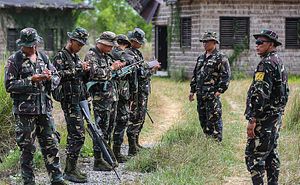In a significant development, India recently decided to provide financial assistance amounting to $500,000 to the Philippines, to aid Manila in its fight against Islamic State-affiliated terror groups in the troubled Mindanao province. This is the first time India is sending aid to another nation to help it fight terrorism, marking an important development in New Delhi’s attempts to burnish its credentials as an emerging security provider in the wider Asian region.
For a long time, India has been trying to convince the world that it remains one of the worst victims of terrorism. But its focus has largely been on Pakistan’s use of terrorism as an instrument of state policy. And while India has viewed Pakistan as the epicenter of terrorism, the world remained reluctant to put adequate pressure on a nation that was seen as a close ally in the post-2001 global war against terrorism.
Under the Modi government, India has taken a tough stand on Pakistan’s support for terrorism by underscoring its concerns in various international forums about terrorism emanating from Pakistan. But while the rest of the world has a greater appreciation of India’s terror problem now, there is a growing expectation that India too will play a greater role in global counterterror efforts. In this context, India’s support to Manila shows a new-found sense of urgency in standing shoulder-to-shoulder with other victims of terrorism, even when the source of the problem might be different.
The siege of Marawi City, about 800 km south of the capital of Manila, began in late May when Philippines security forces launched an offensive to capture Isnilon Hapilon, leader of the ISIS-affiliated Abu Sayyaf group. Despite the military offensive, militants remain in control of Marawi, which is viewed as key in their efforts to create an ISIS province. The civilian toll has been rising and their situation is becoming grave, with more than 500 people having been killed and nearly 400,000 civilians displaced. Philippine President Rodrigo Duterte has taken a hard-line, vowing to “crush” the militants and declaring martial law over the entire southern Philippines. Yet the end of the conflict is not in sight.
India has expressed its concern at the situation and used this crisis to enhance anti-terror and de-radicalization partnerships with the Philippines. India is also conducting cybersecurity training for the Philippine security forces, focusing on de-radicalization. And with last week’s financial aid, India has emerged as the largest donor for this crisis. China has provided 15 million pesos in aid, compared to 25 million from India.
The Delhi-Manila counterterror engagement comes at a time when, with the recent fall of Mosul and the fight for Raqqa intensifying by the day, there are suggestions that the days of the ISIS in its current shape are numbered. It is true that the Islamic State of today is a pale shadow of its past; at its peak, the end of 2014 through 2015, ISIS controlled territory comprising roughly 110,000 square kilometers across both Syria and Iraq. But the underlying forces that gave rise to the emergence of ISIS in the Middle East remain as potent as ever and its ideological attraction is not going anywhere in a hurry. The ideology’s discontents are also haunting India in myriad ways, despite limited inroads made by ISIS in the country so far. In many ways it is imperative for India to take a more proactive role in the global struggle against ISIS. Its aid to Manila might seem to suggest that New Delhi is serious about the problem and its own role in the comity of nations.
India’s engagement with the Philippines is also key to underscoring New Delhi’s growing role in Southeast Asia, where China’s rise has already created serious challenges for the wider region. Regional states are looking at external balancers at a time when America’s commitment to regional security has come under a scanner under the Trump administration. The regional security architecture is under strain as China’s divide and rule approach has made it difficult for regional states to put up a united front. Many states have suggested that India needs to play a larger role. As India and ASEAN celebrate 25 years of their partnership this year; it is a politically opportune moment to upgrade India’s regional profile.
The Philippines has also been trying to recalibrate its ties with Beijing, which have been under stress because of a suit brought by the Philippines to the Permanent Court of Arbitration in The Hague challenging China’s maritime entitlement claims across almost all of the South China Sea. Though Manila won the case, it has not been able to push Beijing to moderate its stand on the maritime dispute. Duterte visited China last October and signed deals worth $24 billion in infrastructure investment and loan pledges. India cannot easily match China’s growing economic profile in the region, but it has other means to build partnership with a very important region in its foreign policy matrix. India’s recent outreach to Manila is an important step in that direction. Hopefully, it won’t be the last.

































